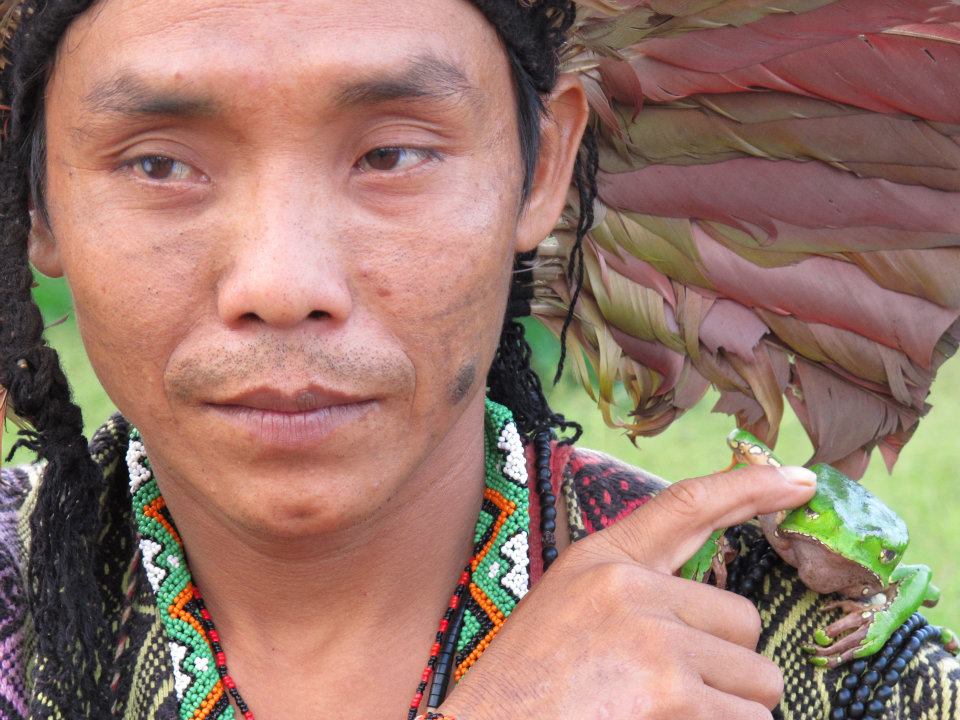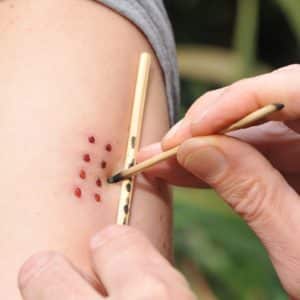Kambô Frog Medicine: An Unconventional Path to Healing

Ouch! I practically jump out of my skin as the medicine woman burns me with a stick. She does this twice more. She then spits on a piece of bamboo, vigorously scrubbing it with a small knife. As she scrapes, small globules that resemble boogers start to form. She then applies the blobs to my three round burn marks on my upper arm.
Within a minute my heart starts to pound. My fingers start to vibrate. My head fills with pressure. I begin to feel hot.. I then start explosively vomiting into a bucket, feeling it wring out my gut like a wet rag. With my swollen face, every purge I make a noise that resembles a frog’s croak.
“What have I done to myself?” I thought. “I am dying!”
After a few urgent bathroom runs and some heavy panting, my body starts to return to normal. Now that the discomfort is gone, I feel a gentle glowing euphoria sweep over my body. I meditate and begin to receive powerful insight into my health, my ancestors, and childhood emotional trauma that has festered into an autoimmune disease. A sense of peace and gratitude fills my every vibrant cell. For the first time I can remember, I am not in pain.
My first time having frog venom rubbed into my wounds was pretty typical of a kambô experience.

Used with the kind permission of Simon Scott, www.kambocleanse.com
The Poison That Cures
Kambô or sapo is an ancient Amazonian medicine used by the natives in South America. It involves the application of the secretion from Phyllomedusa bicolour to burns created on the skin. This practice was first discovered by Westerners in 1986 by the journalist Peter Gorman, who was spending time with the Matses tribe. The Matses would use it before embarking on multiple day hunting trips. The kambô treatment allegedly gave them increased stamina, visual acuity, hearing ability and a reduced need for food and water. They would also use it to cure illness, giving it to the women and children in their village when in need.
These days, hunting is hardly a requirement. So why are people in the Western world using this medicine?
Those that have used kambô report amazing health and spiritual benefits. People with a variety of physical ailments report improvement and sometimes even miraculous recovery from things such as depression, addiction, autoimmune diseases, chronic illnesses, crohns disease, lyme disease and even bad luck! Kambô is non-hallucinogenic but still delivers a subtle, yet powerful spiritual shift for many. In addition to helping many resolve emotional trauma, people find more self awareness and motivation to make positive changes in their daily habits. Some even claim that the external world is mysteriously affected by doing kambô. Strong synchronicities start to emerge and many have an undeniable belief that the frog is responsible.
The frogs are not harmed in the process of collecting the secretion. The natives believed that to harm the frog would bring bad luck. The secretion can only come from wild-caught frogs living in the amazon jungle. Frogs in captivity cannot produce it. Some speculate that the frogs’ natural diet may play a role in the production of the secretion. The frog’s limbs are gently tied and its back stroked with a stick to provoke the secretion of the poisonous “sweat.” The frog is then released back into the wild, unharmed.
The Science of Kambô
Since its discovery by the Western world, scientists have been racing to identify chemical compounds in the cocktail the frog secretes from its skin. Many compounds have been isolated, patented and are being investigated in clinical trials as pharmaceutical medications. The secretion contains hundreds of bioactive peptide molecules. Some have opioid receptor binding activity, as well as adenosine interactive peptides. Many display powerful antibiotic, anti-cancer, anti-inflammatory and pain killing properties.
“This medicine seems to be extraordinary for modulating the immune response, recalibrating the nervous system and overall helping bring the body back to a state of balance.” Says Sarah Churchill, an IAKP certified kambô Practitioner.
Despite the outward appearance of the violent effects kambô produces, it is quite safe when administered by an experienced practitioner. As with even the safest medicine, there are some contraindications for people who should not use kambô. Those with heart conditions, Addison’s disease, receiving chemotherapy or individuals in poor health may not tolerate the medicine very well. In general though, kambô seems to be quite helpful for most people regardless of their complaints.
My own battle with Lyme disease and other chronic health struggles led me to this strange and mysterious medicine. It has by far been one of the most powerful tools for me to regain my health. After experiencing this potent healing modality, I knew that I had no choice but to be in service to this medicine. I am now a kambô practitioner and have the great honor of sharing this medicine with others.
What Does the Future Hold for Kambô?
As bizarre and uncomfortable as the experience is, more and more people are seeking out this jungle medicine. With biotech companies racing to patent new pharmaceuticals derived from kambô, the future of the medicine is in question. Luckily, given the complexity of the chemistry of kambô, it is unlikely that any pharmaceutical company will ever be able to recreate the secretion as a whole. The irreproducible intelligence of kambô is beautiful and contains so much more than the sum of all of its peptides combined. With the conservation of healthy jungle ecosystems under threat, one must wonder how the Giant Green Monkey Frog will fare during these massive ecological changes. Hopefully environmental efforts, and inability to be replicated will preserve the sacred power this medicine has to offer.
How can I learn more?
To learn more about kambô, read some Frequently Asked Questions and visit the International Association for Kambo Practitioners website.
Sources:
- Gorman, P. (2015). Sapo in my Soul (1st ed.). Gorman Bench Press.
- den Brave PS1, Bruins E2, Bronkhorst MW1. Phyllomedusa bicolor skin secretion and the Kambô ritual. (2014). J Venom Anim Toxins Incl Trop Dis. Sep 2;20:40. doi: 10.1186/1678-9199-20-40. eCollection 2014.
- Erspamer V1, Erspamer GF, Severini C, Potenza RL, Barra D, Mignogna G, Bianchi A. (1993) Pharmacological studies of ‘sapo’ from the frog Phyllomedusa bicolor skin: a drug used by the Peruvian Matses Indians in shamanic hunting practices. Toxicon. Sep;31(9):1099-111
- International Association for Kambo Practitioners. www.IAKP.org
Image Credits:
